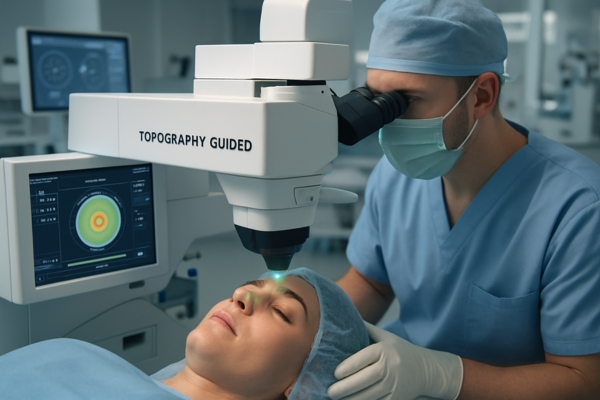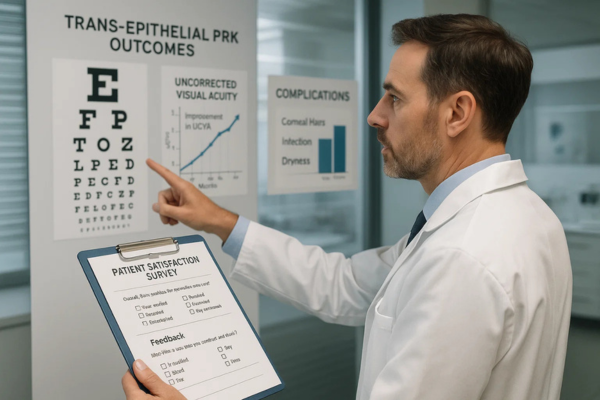Transepithelial PRK (photorefractive keratectomy) has emerged as an advanced form of laser eye surgery, offering a safer and more effective alternative for vision correction. As a key procedure in the UK for treating nearsightedness, farsightedness and astigmatism, it represents a significant advancement in refractive surgery techniques. Unlike traditional PRK, which involves manually removing the corneal epithelium, transepithelial PRK uses a laser to gently remove the epithelial layer, reducing discomfort and speeding up recovery times for patients.
This article explores the latest advancements in transepithelial PRK surgery, reviewing the clinical outcomes in the UK and focusing on the benefits and considerations of this technique for both patients and healthcare providers.
How Has Transepithelial PRK Surgery Evolved in the UK?
The Evolution of Transepithelial PRK Surgery
Transepithelial PRK has seen substantial improvements in its technology and technique, enhancing its safety and efficacy. This advanced form of PRK is gaining popularity in the UK due to its less invasive nature and quicker recovery compared to traditional PRK.

Key Advancements in the Procedure
- Laser-Assisted Epithelial Removal: Transepithelial PRK uses a laser to remove the epithelium, eliminating the need for mechanical scraping. This approach minimizes trauma to the cornea and promotes faster healing.
- Better Precision with Topography-Guided Systems: The integration of topography-guided laser systems allows for more precise treatment, mapping the cornea’s unique shape to correct higher-order aberrations and achieving better visual outcomes.
- Minimized Discomfort and Faster Healing: By preserving the corneal surface during the procedure, patients experience less post-operative discomfort and a reduced risk of complications, such as haze or infection.
These advancements are reshaping the landscape of laser eye surgery in the UK, offering patients more personalized and efficient treatment options.
Why is Transepithelial PRK Surgery Gaining Popularity in the UK?
Increasing Demand for Safer, Faster Recovery Procedures
Advantages of Transepithelial PRK Surgery
- Reduced Risk of Corneal Flap Complications: It involves creating a flap in the cornea, transepithelial PRK does not carry the risk of flap dislocation or complications. This makes it particularly attractive to patients with thinner corneas or those who engage in high-impact activities.
- No Need for Flap Retention: The lack of a flap in transepithelial PRK eliminates the risk of complications associated with flap creation and retention, making it a safer option for long-term eye health.
- Lower Risk of Dry Eyes: Studies have shown that transepithelial PRK may have a lower risk of causing dry eye syndrome, which can be a significant consideration for many patients.
These factors, combined with improved visual outcomes, are driving the growing popularity of transepithelial PRK surgery in the UK.
Testimonials
“Extremely gentle, professional and informative, Could not wish for more“
Where Transepithelial PRK Procedures Are Most Commonly Performed in the UK?
Access to Cutting-Edge Technology and Expert Care
Transepithelial PRK surgery is increasingly being performed across the UK, with major cities such as London, Manchester and Birmingham seeing a high concentration of clinics offering this advanced treatment. Healthcare providers in these areas are adopting the latest technologies to ensure that patients have access to safe, effective and precise treatments.
Key Locations and Institutions Leading the Way
- Private Clinics and Specialized Eye Centres: These facilities are often the first to offer new procedures and technologies like transepithelial PRK. With specialized staff and cutting-edge equipment, they provide patients with optimal care and quicker access to surgery.
- NHS Hospitals with Refractive Surgery Units: While the NHS is typically slower to adopt new technologies, some public hospitals in the UK have incorporated transepithelial PRK into their refractive surgery offerings, making the procedure accessible to a wider range of patients.
Client Speaks
“I am confident about this doctor“
When Can Patients Expect to See Results After Transepithelial PRK Surgery?
Recovery Times and Visual Improvements
Recovery Timeline and Expected Outcomes
- Initial Healing (First Few Days): During the first few days, patients may experience some discomfort, light sensitivity and blurry vision. This is normal and generally subsides as the cornea heals.
- Short-Term Recovery (First Week): Patients typically experience significant improvement in vision within the first week, although their vision may fluctuate as the corneal surface continues to heal.
- Long-Term Recovery (Up to 3-6 Months): Full visual stabilization may take several months, with the final outcome becoming clearer as the corneal epithelial cells regenerate. It is important to attend follow-up appointments to monitor healing progress.
Overall, most patients in the UK experience rapid recovery and satisfactory vision correction within the first few months, with minimal discomfort and downtime.
How Are Clinical Outcomes of Transepithelial PRK Surgery Measured in the UK?
Tracking Success Rates and Patient Satisfaction

Key Factors in Measuring Clinical Outcomes
- Visual Acuity: One of the most important measures of success is the improvement in uncorrected visual acuity (UCVA). Patients often experience a significant reduction in their dependence on glasses or contact lenses.
- Patient Satisfaction: Surveys and patient feedback are essential in evaluating the subjective outcomes of surgery, such as comfort, visual clarity and overall satisfaction with the procedure.
- Complication Rates: The frequency of complications such as corneal haze, infection or dryness is closely monitored. Advances in transepithelial PRK have helped reduce these risks, leading to higher satisfaction rates and better outcomes.
Conclusion
Advances in transepithelial PRK surgery have transformed the landscape of refractive eye care in the UK. With improvements in laser technology, faster recovery times and reduced complication rates, transepithelial PRK is quickly becoming a preferred choice for vision correction. The technique offers patients an effective, safe and precise solution, particularly for those who may not be suitable candidates for surgery.
As more patients in the UK seek out transepithelial PRK, the procedure’s clinical outcomes continue to demonstrate its effectiveness in delivering superior vision correction. With ongoing advancements and increased access to cutting-edge technology, the future of transepithelial PRK surgery looks promising for both patients and healthcare providers.
Frequently Asked Questions - Transepithelial PRK Surgery
Q1. What is transepithelial PRK eye surgery?
A. Transepithelial PRK is a form of laser eye surgery that uses a laser to remove the corneal epithelium, rather than manually scraping it off as in traditional PRK. This method offers a gentler procedure with quicker recovery times and reduced post-operative discomfort.
Q2. How long does it take to recover from transepithelial PRK surgery?
A. Recovery from transepithelial PRK typically takes several weeks to months. Initial discomfort and vision fluctuations may occur during the first few days, but most patients experience significant improvement within the first week. Full visual stabilization may take up to six months.
Q3. What are the benefits of transepithelial PRK compared to traditional PRK?
A. The key benefits of transepithelial PRK include reduced discomfort, faster healing and a lower risk of complications like corneal flap issues. It is particularly beneficial for patients with thin corneas or those at higher risk for complications.
Q4. Are there any risks associated with transepithelial PRK surgery?
A. As with any surgery, there are some risks, including infection, dry eyes and corneal haze. However, the advancements in transepithelial PRK have significantly reduced these risks and the procedure is generally safe with proper post-operative care.
Q5. How can I determine if I am a good candidate for transepithelial PRK surgery?
A.
A comprehensive eye examination by a qualified surgeon is necessary to determine if you are a suitable candidate for transepithelial PRK. Factors such as corneal thickness, overall eye health and refractive error will be evaluated to ensure the best possible outcome.
